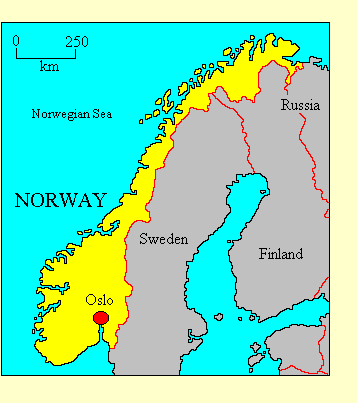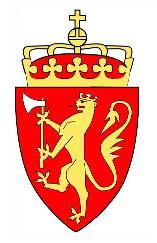

KINGDOM OF NORWAY
• Official name: Kongeriket Norge (Kingdom of Norway)
• Location: Western Europe
• International organisations: Council of Europe, North Atlantic Treaty Organisation, Organisation for Economic
Co-operation and Development, Organisation for Security and Co-operation in Europe, United Nations, World Trade Organisation
• Borders: Finland, Russia, Sweden
• Coastline: Norwegian Sea
• Land area: 324,220 Km2
• Population: 4,900,000
• Annual GDP (PPP) per capita: US$58,600 (2009 CIA estimate). World ranking: 4
• Ethnicity: Almost the entire population is of Norwegian stock. There is a small
Sami minority in the far north.
• Languages: Norwegian is the official language and is universally used. There are
small Sami and Finnish-speaking minorities in the north.
• Religion: The Evangelical Lutheran Church is a state church, but freedom of
religion is guaranteed. Nearly 90% of the
population are nominal Protestant Christians, but Norway is a highly secularised
country. There is a small Catholic Christian minority.
• Form of government: Constitutional monarchy and parliamentary democracy.
Norway is divided into 19 counties.
• Capital: Oslo

• Constitution: The
Constitution of the Kingdom of Norway came into effect on 17 May 1814.
It was substantially modified in 1884.
• Head of state: King Harald V came to the throne on 17 January 1991.
• Head of government: The Prime Minister, appointed by the King. The
Prime Minister is the leader of the largest party in the legislature and
is accountable to it.
• Legislature: Norway has a unicameral legislature, the
Great Council (Stortinget), which has
165 members, elected for four-year terms by proportional
representation from multi-member constituencies. There is a deliberate malapportionment on favour of the sparsely
populated northern counties.
• Electoral authority: The National Electoral
Committee administers national elections
• Freedom House 2011 rating: Political Rights 1, Civil Liberties 1
• Transparency International Corruption Index: 86% (10 of 178 countries rated)
• Reporters Without Borders Press Freedom 2010 Index: 100% (1 of 178 countries rated)
• Heritage Foundation Economic Freedom 2010 Index: 70.3% (30 of 178 countries rated)
Political history
The mediaeval Norwegian kingdom was merged with Denmark and Sweden by the Union of
Kalmar in 1387, and Norway was under the Danish crown until the Napoleonic Wars. In
1814 Sweden claimed Norway as the price of its support for the Allies, and despite a
Norwegian declaration of independence the Congress of Vienna awarded Norway to Sweden.
When Sweden became a constitutional state in 1867, the Norwegians revived their
claims to independence. After many years of tension and conflict, Sweden agreed to
Norwegian separation in 1905. A prince of the Danish royal house became King
Haakon VII of Norway. The 1814 constitution was revived and Norway became a parliamentary democracy.

After World War I the Norwegian Labour Party
became increasingly powerful, and is 1935 it came to power. Norway was occupied
by Germany in 1940 and the King and Cabinet went into exile in Britain. In 1945
Norway was liberated and Labour returned to power, holding office until 1965.
Since 1965 Labour has alternated in power with the conservative coalition of
the Right Party, the
Christian People's Party, the
Centre Party and the
Liberal Party. Also on the right is the
populist Progress Party. The
Socialist Left Party is to the left of Labour. Both
Labour and the conservative parties favour entry to the European Union, but the
voters have twice rejected membership at referendums.
The Christian Democrat Kjell Magne Bondevik led a conservative coalition government from 1997 to 2000,
when he was succeeded by Labor's Jens Stoltenberg.
Bondevik returned to office after winning the 2001 election, but in 2005 Stoltenberg won a narrow election victory and
formed a coalition government with the Socialist Left and Centre parties. He was re-elected with a slightly reduced majority
in 2009. At both elections Labour was assisted by the electoral system, which gives disproportionate representation to the
sparsely populated northern counties where Labour is strongest. In 2009 the four right-wing parties polled 49.6% of the vote
but won fewer seats than the governing coalition, which polled 47.7%.
Updated November 2011
|


